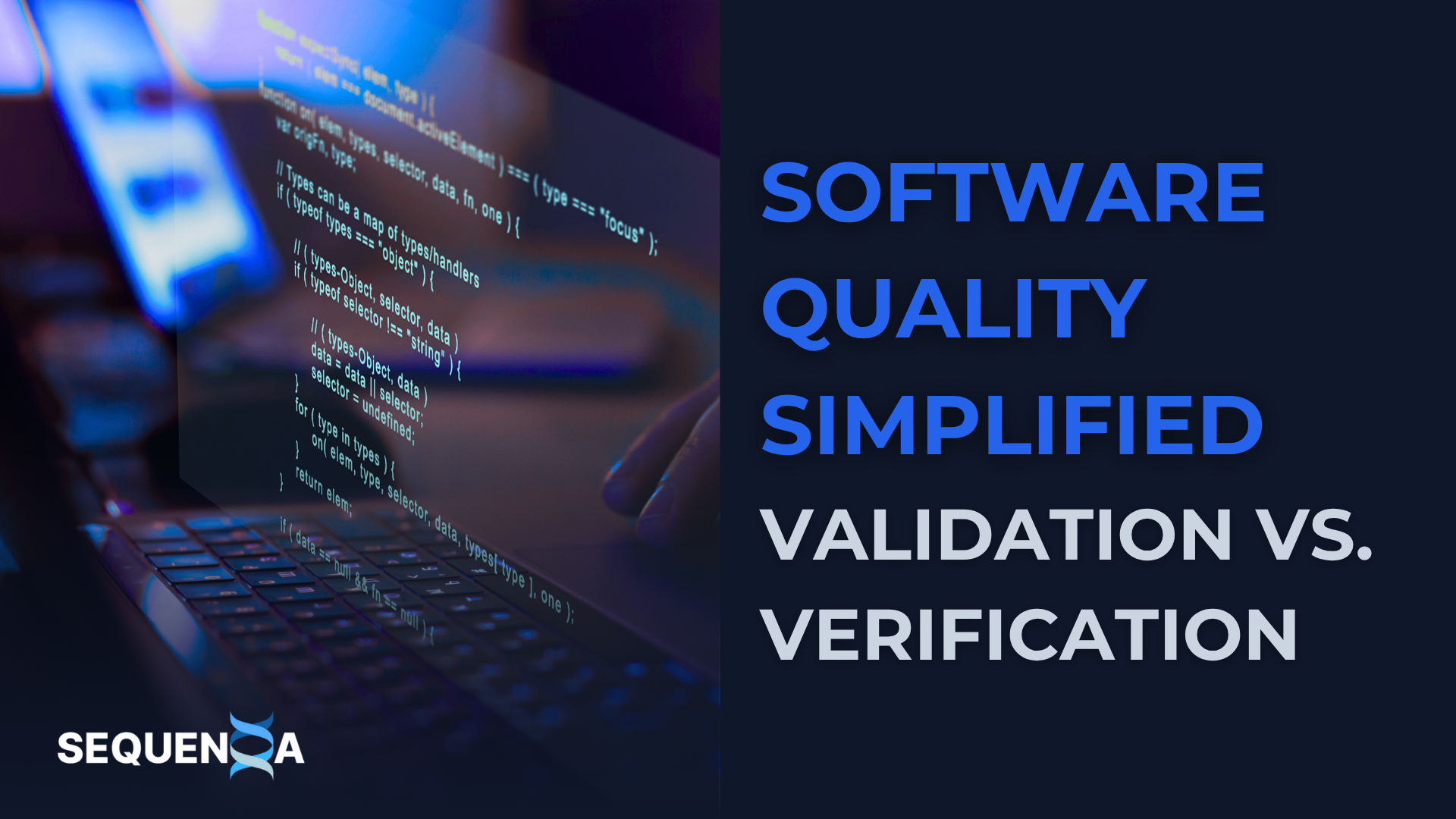Software Quality Simplified: Validation vs. Verification

In software development, defects slipping into production are costly, both in time and trust. Many teams test thoroughly yet still release unstable or non-compliant products. This often stems from a lack of clarity around validation and verification testing. These two processes serve distinct but equally vital roles in ensuring quality software delivery.
This article unpacks the difference between verify and validate, provides definitions, highlights examples, and helps you understand when and how to apply each. We’ll explore key topics like verification and validation in software testing, common pitfalls, industry examples, and expert-backed best practices, anchored to high-level guidance from FDA software validation and NIST systems engineering.
Define Verification and Validation
Many product teams think testing alone ensures quality. But without distinguishing between software verification vs validation, defects can remain undetected until customers report them, when it's too late. To clearly understand the validation verification definition, it’s important to know that verification and validation means applying two complementary approaches to ensure both correctness and suitability of a product. It helps to note that these are complementary checks recognized in NIST SP 800-160 and FDA guidance.
Verification means checking if the product was built right
This involves confirming that the software meets specified design requirements and functions correctly before execution. Static methods like reviews, walkthroughs, and inspections are used here. In other words, when we explain verification and validation, verification is about ensuring the product’s internal structure and design align with the specifications.
Validation means checking if the right product was built
It ensures the software meets user needs and performs as expected in real-world scenarios. Typically performed through dynamic testing, simulations, and UAT (User Acceptance Testing). When looking at validation vs verification in software testing, validation focuses on the end-user perspective and real-world performance, while verification ensures the design and build are correct before actual execution. In regulated industries, validation aligns with broader risk-management and audit practices.
Example: A healthcare app's login system passes verification when it meets encryption and design specs. It passes validation only if real users can access it smoothly under typical network conditions.
Need audit-ready identity & document checks across your SDLC? Verify with Sequenxa Origin
Verification Testing in Practice
Verification is the frontline defense against technical errors. It happens early and often throughout the software lifecycle.
Requirement Reviews
Requirement reviews help ensure that all documented requirements are complete, consistent, and unambiguous before development begins. This early form of verification and validation testing plays a crucial role in confirming that the software's foundation is built on accurate expectations. Addressing issues at this stage helps verify and validate requirements and prevents costly mistakes from cascading into design or code-level defects.
Design Inspections
Design inspections involve analyzing the software's architecture, algorithms, and interface specifications to confirm they’re technically sound and aligned with the project’s objectives. This step allows teams to differentiate between validation and verification, as it focuses on ensuring the design correctly implements the requirements. Early-stage validation ensures the proposed solution supports intended functionality before moving into implementation.
Code Walkthroughs and Static Analysis
Through code walkthroughs and static analysis, teams can catch syntax errors, logic issues, and even security flaws without running the code. These techniques are part of software validation verification strategies that focus on code correctness, maintainability, and compliance with standards. They strengthen the overall codebase and help verify vs validate software testing procedures before runtime testing begins.
Did you know? 56% of software bugs originate during the requirements and design phase (IBM Systems Science Institute, 2023).
“Verification is your first opportunity to catch miscommunication before it becomes malfunction.”
What types of software projects might benefit most from heavy verification testing?
Validation Testing in Software Testing: Meeting Demands
Unlike verification, validation ensures the product behaves correctly for the end-user under real or simulated conditions.
System and Integration Testing
System and integration testing evaluates how individual modules interact and how the system performs as a unified whole. This process is crucial to verify and validate that components are correctly integrated and that no functional gaps or incompatibilities exist. It's a key part of both verification and validation in software testing, ensuring that the system behaves as specified.
User Acceptance Testing (UAT)
User Acceptance Testing involves real users testing the software in practical, real-world scenarios to confirm it meets business needs and expectations. This form of validation testing in software testing helps uncover usability issues and ensures the solution aligns with workflows before full-scale deployment. UAT is a final step to validate vs verify that the product works for its intended audience, and it benefits from clear compliance alignment.
Performance and Stress Testing
Performance and stress testing assesses how software handles expected and extreme loads, including speed, responsiveness, and scalability. These tests are essential for software validation verification, ensuring that the system performs reliably under all operational conditions. It’s not only about whether the system works, but whether it works well, under pressure.
“Validation proves that your assumptions about the user are correct, before your customers prove them wrong.”
How can validation testing influence your product’s success in regulated industries?
Verification vs Validation in Software Testing
Understanding the validate vs verify distinction enhances both planning and execution across testing efforts.
Focus
When comparing verification and validation, the core difference lies in the question each process answers. Verification asks, “Did we build the product right?”, ensuring the product aligns with documented specifications. Validation, on the other hand, asks, “Did we build the right product?”, ensuring the final output meets actual user needs and intended use cases. This fundamental distinction helps teams differentiate verification and validation at every stage and supports audit-ready governance.
Timing
Verification occurs early in the lifecycle, before any code is executed, during stages like design reviews and documentation analysis. Validation takes place after execution, through hands-on validation testing in software testing, often involving test environments, pilot users, or production-like simulations. Understanding this software verification vs validation timeline is key to applying the right checks at the right time.
Techniques Used
To verify and validate effectively, different techniques are used for each. Verification relies on static methods such as audits, walkthroughs, and formal inspections to ensure correctness without running the software. Validation uses dynamic testing methods like simulations, user testing, and functional test cases, answering the real-world question of “Does it work as expected?” This clear contrast explains the validate verify difference and supports thorough verification and validation testing.
Did you know? Teams that implement both verification and validation reduce post-release bugs by 65% (CIO Insights, 2024).
Need a clean, phase-by-phase verification of who approved what? Set identity checks per phase in Origin
Common Pitfalls: Difference Between Verification and Validation
Teams often blur the line between verifying specs and validating outcomes, resulting in missed issues or user dissatisfaction.
Assuming Passing Test Cases Equals Real-World Readiness
One of the most common mistakes in software projects is assuming that passing test cases automatically means the product is ready for end users. While these tests may confirm technical correctness (verification), they often fail to measure real-world usability or fit (validation). This misunderstanding highlights the difference between verification and validation, where checking specs isn't the same as ensuring user satisfaction.
Skipping Reviews in Agile Sprints
In Agile development, the push for speed can sometimes bypass essential verification activities like design reviews and static analysis. Without these checks, architectural or logic flaws may go unnoticed until they cause defects downstream. Proper verification and validation in software testing must be baked into every sprint to maintain long-term quality.
Delaying Validation to the Final Stages
Postponing validation testing until the end of a project often leads to rushed fixes for usability, accessibility, or compliance issues. Real users may not see the product until it's nearly complete, limiting the opportunity for meaningful feedback. This reactive approach undermines the value of software validation verification and blurs the lines in validate vs verify software testing practices.
“Verification without validation is like checking the blueprint but never testing the building’s safety.”
What’s the cost of missing the difference of verification and validation in high-stakes industries like aviation or p
Example of Validation and Verification
Understanding how both apply in real scenarios builds clarity and confidence in implementation.
Verification
In regulated industries like healthcare, verification involves engineers confirming that all software components meet FDA-mandated specifications and safety requirements. This is typically done through detailed design documentation, peer reviews, and static analysis, making it a textbook example of validation and verification in high-risk environments. This process helps define verification and validation clearly by ensuring the system is built right before deployment.
Validation
Validation goes a step further by involving clinical users, such as doctors, nurses, or lab technicians, to test the software in real-world medical settings. The goal is to ensure the product is usable, safe, and aligned with clinical workflows, so patient care isn't compromised by a confusing interface or delayed alerts. This kind of validation in software testing guarantees the system functions as intended when it matters most.
Did you know? Over 70% of FDA software recalls cite failure in either verification or validation (FDA, 2023).
How could early V&V testing have prevented major software recalls in healthcare or automotive sectors?
How to Differentiate Verification and Validation in Practice
Using a balanced, clear approach helps teams avoid confusion and achieve compliance and customer satisfaction.
Create Separate V&V Checklists
Developing distinct verification and validation checklists ensures that both technical requirements (verification) and business or user needs (validation) are properly addressed. This structured approach helps teams avoid confusing one for the other, minimizing the risk of overlap or omission. It's a practical way to implement the validate verify difference in real-world project management.
Document Each Testing Phase Distinctly
Clearly labeling and separating each testing phase, from unit tests to UAT, removes ambiguity when presenting results or maintaining audit trails. This is particularly important in regulated industries where traceability and compliance matter, such as medical devices or aerospace. Thorough documentation supports effective verification and validation testing and aligns with industry standards.
Train Teams on the Validate Verify Difference
Misunderstanding the validate verify difference can lead to critical gaps in the development lifecycle. Training cross-functional teams on how to differentiate verification and validation builds shared accountability and prevents assumptions that one process covers both. This awareness improves communication and reinforces best practices in software validation verification.
“A software project succeeds not only by working, but by working for the right reason and the right people.”
FAQs
What is the validation verification definition?
Validation checks if the right product was built for user needs. Verification checks if the product was built right per specifications.
What is an example of validation and verification?
In e-commerce: Verification ensures the shopping cart follows coding specs; validation ensures users can complete purchases smoothly.
Why differentiate between validation and verification?
It helps ensure that both technical accuracy and user satisfaction are achieved, essential for reliable, scalable software.
What is the validate and verify testing difference?
Validate testing involves real-world use, while verify testing involves design and code inspection.
How does validation versus verification apply in software testing?
Validation focuses on behavior in live scenarios; verification ensures technical requirements are met before release.



